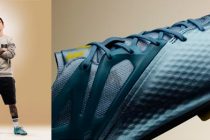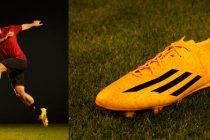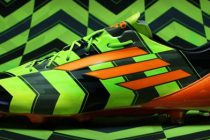Traditionally, boot design starts with a sketch, but there is nothing traditional about the brand new PhantomVSN.
To create something different and better, designer Phil Woodman started conceiving of this boot from the inside out. This resulted in a proprietary new construction that will debut in football with the PhantomVSN and soon be adopted in other Nike footwear.
“We developed an internal Quadfit mesh bootie that conforms to fit most any foot, but retains its shape and will not overstretch,” says Woodman. “Quadfit contains the foot without constricting the foot.”
While not visible from the outside, the impact is immediate on the inside. “Players have long been accustomed to the rigors of breaking in their boots,” explains Woodman, “but the PhantomVSN is match-ready right out of the box.”
Quadfit performs well because it doesn’t have the stretch bias typically seen in woven materials. The four axes of fibers conform to the player’s foot and provide support in all directions. It works because of the unique fiber orientation as well as the separation between fibers; the gaps distribute the load of the foot and mitigate friction. The result is an incredible fit across a very broad spectrum of unique foot structures.
Improved lacing equals customized fit
Another unseen item within the PhantomVSN is the appropriately named Ghost Lace system. “We’ve done tremendous amounts of research, talking with players and analyzing data in the lab,” explains Woodman, “and the results are unanimously in favor of lacing to provide that customized fit each player desires.”
To improve upon traditional lacing, the Ghost Lace touchpoints were minimized and a one-pull construction implemented for equal tension all the way down the foot. The laces can then be discretely tucked away to provide an even striking surface.
Advancing touch
The hidden innovations on the PhantomVSN reside within a highly texturized Nike Flyknit upper designed to provide premium touch on the ball.
The data-informed placement of the triangulated texture of the Nike Flyknit corresponds with NSRL (Nike Sport Research Lab) data on ball control. This is further emphasized by the boot’s dominant visual cue, the medial triangle. “The triangle roughly covers the surface between 3 prominent bones in the foot: the calcaneus, talus, and first metatarsal head. This provides an intuitive connection to the area our research deems critical to ball control,” says Woodman.
NSRL testing confirms the lower on the triangle one collects the ball, the higher the degree of control for initiating the attack. “When we think of the phantoms we are designing for, we envision a battler who has mastered the art of navigating tight spaces while possessing the vision for attack lanes others may not see. The phantoms would be at ease in a position-less environment and accustomed to multi-directional maneuvers with the ball at their feet,” says Woodman, while noting the influence of small-sided football on the design.
With small-sided football playing such a prominent role in the design of PhantomVSN, it makes sense that the small-sided version of the boot would be constructed with attention to detail and the best technology Nike has to offer, including NikeReact cushioning and an extra durable upper for the rigors of the street.
Dialed traction for any field of play
The cleated version features an entirely new FEA-informed traction pattern to accommodate quick multi-directional cuts. The studs are housed on a lightweight, responsive plate with enhanced zonal support for the foot.
Both the small-sided and cleated versions of PhantomVSN are designed to perform in the elements with ACC (All Conditions Control) coating weather-proofing the product.
The long list of Nike players planning to play in the PhantomVSN includes Philippe Coutinho, Mallory Pugh, Kevin De Bruyne, Fran Kirby, and Leon Goretzka.
What the players are saying
(Nike)







Follow me on Social Media